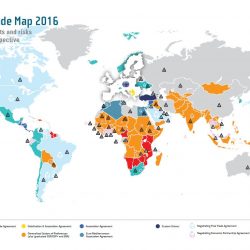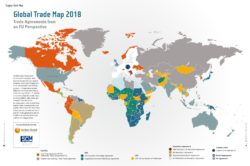New: Global Trade Map 2016

Uncovering and mitigating trade risks in international operations
International trade can entail significantly more risk than straightforward domestic business-to-business transactions. In collaboration with Amber Road, Supply Chain Movement has put together this Global EU Trade Map which provides an overview of current EU trade agreements and an insight into potential trade risks and how to mitigate them.
By Supply Chain Movement in collaboration with Amber Road
According to Aberdeen Research, “international shipments cost twice as much, take five times as long and have five times more variability than domestic shipments.” Consequently, if a company is involved in overseas operations it is often exposed to a higher degree of risk, which in turn can significantly impact bottom-line growth and affect success across intra-company departments. While it is not possible to eliminate all the risks, international trade agreements between the European Union (EU) and other countries/regions can help to minimise the financial risk by reducing customs duties payable and improving market access.
Free Trade Agreements and Preferential Trade Agreements
Free Trade Agreements (FTAs) and Preferential Trade Agreements (PTAs) are designed to boost economic growth through trade by opening markets by way of progressive removal of customs duties, eliminating or reducing trade barriers and tariffs, lifting restrictions on services and even through public procurement.
EU FTAs and PTAs range from the classic FTA, such as between the EU and Mexico (which focuses predominantly on liberation of goods and services), to more enhanced forms of the FTA like the Deep and Comprehensive Free Trade Area (DCFTA), between the EU and Ukraine for example. Besides liberating tariffs on goods and services, this also covers aspects such as fair competition, intellectual property rights, basic workers’ protection or environmental standards and the use of subsidies and anti-competitive behaviour. It lays the foundation for gradual alignment of norms and standards, including on food safety and technical regulations.
The benefits of utilising modern-day FTAs include fewer customs duties, less red tape, access to public tenders, sourcing opportunities, investment opportunities and more transparent business conditions. However, companies making use of an FTA must comply with the terms of the specific agreement. These can be complicated and are amended regularly, making it a complex and time-consuming process to understand which rule apply and to what extent. As a starting point for companies looking for ways of reducing financial risk and achieving cost savings in their international business activities, this Global EU Trade Map provides an at-a-glance overview of the EU trade agreements currently in place or under negotiation.
Getting to grips with EU trade agreements
Best-in-class companies have strategically aligned their in-house practices with the relevant EU trade agreements they wish to make use of. Operations, customs, supply chain, legal and/or logistics departments are brought together during the product procurement process to ensure that imported components and finished products meet the terms of the relevant free trade agreement. Such an approach enhances compliance and reduces the potential for further costs related to post-clearance audits/checks by customs authorities.
What does the Global EU Trade Map show?
This Global EU Trade Map shows the current FTAs, PTAs and other trade schemes the EU has in place with over 160 countries on six continents, including the Economic Partnership Agreement between the EU and African, Caribbean and Pacific partners, the Generalised System of Preferences (GSP) for developing countries, the Stabilisation & Association Agreement (SAA) with the Western Balkan countries, Association Agreements (AA) which are treaties between the EU and non-EU countries, and the Customs Union, which is the closest form economic integration without joining the EU itself.









